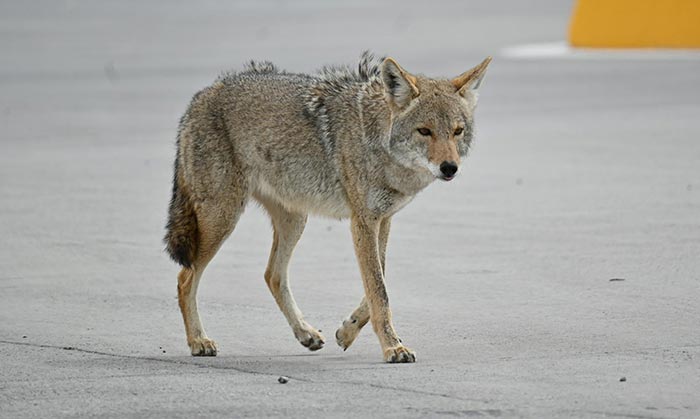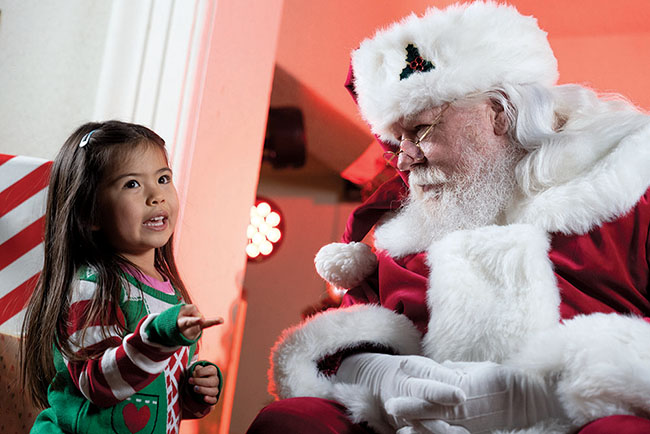Coyote sightings, reports of aggression, spiking in Claremont

Coyote sightings and interactions have spiked in residential areas of Claremont in 2025. Photo/courtesy of pexels.com
by Andrew Alonzo | aalonzo@claremont-courier.com
Rachel Rudich no longer walks her dog or exercises in the Northwestern Drive neighborhood she’s called home since 1992. The reason? A recent spike in coyote sightings, with some attacking pets and other animals in the area.
“I can no longer walk my little 10-pound poodle in my neighborhood. I will no longer walk myself in my neighborhood. It’s just too scary,” Rudich said during public comment at the May 13 Claremont City Council meeting. “…The situation has exploded. It’s way different than any other time in the 30-plus years I’ve lived here.”

Claremont resident Molly Schmid pictured last week in her Ninth Street neighborhood with her 16-year-old dog Kola. She recently began carrying a hiking stick to ward off coyotes. Courier photo/Andrew Alonzo
Other residents shared similar stories at the meeting, saying they’ve observed coyotes stalking humans and pets, and getting bolder in their attempts to find food. Claremont resident Cindy Aguilera Cobian said a coyote recently jumped into her backyard and attacked her dog.
“It’s really sad that we no longer have access to our backyard,” Aguilera Cobian said at the meeting. “Our pets are no longer safe. We’re constantly stalked from them all the time. I see coyotes in my backyard daily … daily.”
Inland Valley Humane Society and SPCA President and CEO Nikole Bresciani said coyotes encroaching into residential areas in Claremont are likely looking for available properties to create dens, taking advantage of food residents leave out for wildlife, or have been displaced by recent wildfires.
Regardless of the reasons, reports of coyotes in residential areas of Claremont have increased dramatically in 2025. Bresciani said her agency has logged 19 calls about coyotes from Claremont since January 1, five regarding aggression and 14 reporting sightings. In 2024, the agency logged eight calls for the entire year, one regarding an aggressive coyote and seven sightings. In 2023, it received just one call, which followed seven in 2022.
“We note whether the Reporting Party states if there is aggressive behaviors/ bites versus sightings in yards etc.,” Bresciani wrote in an email. “Sometimes upon further investigation, a report of an ‘aggressive’ coyote is one that turns into a sighting not actual aggressive act.”
Longtime Claremont residents Elizabeth and Michael McGarry have had run-ins with the coyotes along Ninth Street.
“We’ve never seen anything like this in terms of just, the presence of a particular group of animals in one place all the time,” Michael McGarry said. “The other thing that’s unprecedented is the aggressiveness.”

Cindy Aguilera Cobain plays audio of her dog being attacked by a coyote at the May 13 Claremont City Council meeting. Courier photo/Andrew Alonzo
Elizabeth McGarry said her neighbor Lillian Bass was attacked by a coyote two weeks ago in front of her home while walking her dogs. Like other neighbors, the McGarrys said they spot coyotes during all hours of the day and contend they don’t seem to be affected by attempts to scare them off through “hazing,” which means using deterrents such as noise makers, loud noises, or spraying them with a hose to discourage them from inhabiting a specific area.
Claremont Community Services Director Jeremy Swan said that the city is not aware of incidents in which coyotes have bitten humans. He said most reports have been about near misses with humans and attacks on dogs near Ninth Street.
Ninth Street resident Molly Schmid recently began carrying a hiking stick to ward off coyotes during walks with her 16-year-old dog, Kola. “They just sneak up, and if you’ve ever had a coyote sneak up on you — unlike a dog that may jangle a little bit — coyotes don’t make a sound,” she said.
Chris Hubert, an animal control officer with the Inland Valley Humane Society, said at the council meeting that the agency “is fully aware of the situation and that the residents’ concerns are being heard and we are considering any and all options that are available to us to try and help deal with it,” including working with local and state agencies. “We currently have an officer patrolling the area on daily basis.”
In an email, Bresciani acknowledged the increase in coyote calls from Claremont in 2025, but contended it “does not necessarily equate to coyote presence or activity, just that we are actually receiving the call/report vs. someone contacting California Department of Fish and Wildlife or the [Claremont] Police Department.”
“The overarching issue is about education information and trying to empower people to try to take proactive measures around their properties, making them aware of the hazing process and how they can help deter … You don’t want coyotes to be comfortable,” Bresciani said. “So, the more that we can do that and help people understand, the better. We do not physically go out and trap, unless there is an issue with an injured or an aggressive coyote that is habituated.”
Another source of frustration for residents are the multiple agencies involved with reporting coyote interactions. Some said they have called the city, only to be directed to Inland Valley Humane Society or the California Department of Fish and Wildlife.
Claremont Public Information Officer Bevin Handel said Inland Valley Humane Society is the lead agency for coyote management. Other agencies that assist include Fish and Wildlife and the Los Angeles County Department of Agricultural Commissioner.
“It’s basically a local animal control issue,” Steve Gonzalez, a fish and wildlife spokesperson said. “At fish and wildlife we just tell people [to employ] best practices … If a coyote attacks a person, then we get involved and we’ll investigate and euthanize that coyote. But other than that, it’s just best practices.”
Those best practices include keeping food and trash indoors, walking pets on a leash and keeping them close, having a whistle or noisemaker handy, and traveling in groups, Gonzalez said. And in the event of a coyote bite to a person or pet, both should seek medical attention.
Residents are divided on possible solutions. Some welcome trapping and relocating the animals, others say it’s a live and let live situation.
“We have had many a run in with a number of coyotes from the colleges to El Roble, biting, threatening and generally challenging those of us with canines,” Bass wrote in an email. “There are at least three cases of direct bites, with no brave professional able to make any change. Any dog going around biting three and more dogs would certainly be dealt with differently.”
Swan said Claremont is “researching and assessing all services that are available as we put together an action plan for the future in regard to aggressive or diseased coyotes.” A community meeting is in the works, he said, adding the city is looking into how to create a coyote reporting system.
Online coyote reporting systems are already available from San Gabriel Valley Council of Governments at sgvcog.org/coyotes; LA County Department of Agricultural Commissioner at acwm.lacounty.gov/coyote-sighting-report; and Fish and Wildlife at apps.wildlife.ca.gov/wir. Coyote sightings can also be reported to Inland Valley Humane Society at (909) 623-9777, ext. 673.
For additional guidance, search “coyote” at claremontca.gov.










0 Comments